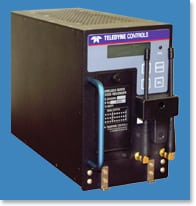 |
| Teledyne’s WGL Comm+ helps remove the use of floppy disks from the avionics software uploading process. Photo: Teledyne |
[Avionics Today 08-29-2014] Despite all of the new technology being packed into the data centric architectures of modern airplanes, many airlines and operators still use outdated technology for a crucial part of their operations — floppy disks. Believe it or not, the majority of Boeing 737 operators — the industry’s best selling passenger jet — are still using floppy disks to load avionics software.
But that process will soon become obsolete, according to William Cecil, director of business development, wireless and data automation solutions at Teledyne Controls. Teledyne, which was awarded the single source contract to provide data acquisition systems for the Boeing Next Generation 737 and the 737 MAX in 2013, will demonstrate how airlines can bring their avionics software uploading process into the 21st century in a
webinar hosted by Avionics Magazine on Wednesday Sept. 3rd.
“Most 737 operators today have a binder of floppy disks for all the software for all the avionics that they may need,” said Cecil. “Right now today, that’s what the majority of the airlines load their monthly Navigation Database with, they load it with the floppy disk and the databases are getting bigger. So sometimes one floppy disk is enough, it can be as many as eight floppy disks. Like the display electronics unit takes eight floppy disks, and it takes maybe an hour or more to perform that loading.”
The Navigation Database (NDB) is part of the aircraft’s Flight Management System (FMS), containing the airports, runways, flight paths and waypoints among other elements necessary for constructing the flight plan that pilots use for scheduled routes.
Sometimes mechanics can reach disk number six or seven during the uploading process, only to find there is a bad disk, at which point they have to start over again, Cecil said. That can potentially lead to a flight delay if the process is occurring for an airline in between scheduled flights. Teledyne’s Wireless GroundLink Comm+ (WGL Comm+) helps to eliminate floppy disks from the uploading process by supporting end-to-end applications, such as the automated wireless distribution of avionics software and databases from an airline’s back office to an aircraft data repository.
Airlines such as Lufthansa, the largest European carrier,
are looking to move away from floppy disks as well. Lufthansa’s medium-haul fleet features legacy Boeing 737-300s and Airbus A320-200s, which could benefit from the automation of avionics software uploading.
“Lufthansa is moving away from 3.5 inch floppy disks like most other airlines. Several new technologies are currently tested or already in use,” said Jens Ritter, head of flight operations and fuel efficiency at Deutsche Lufthansa.
Cecil will be joined
in the webinar on Wednesday by his colleague Murray Skelton, director of business development for operational software solutions at Teledyne and Tom Fodor, assistant director of the engineering and maintenance group for the International Air Transportation Association (IATA) to describe how all airlines can free themselves from floppy disks.
“For two or three years now we’ve actually been using the WGL Comm system to do software uploading to the aircraft,” said Cecil. “We’ve certified that on the 737 and A320 and it’s in operation on a few operators now and it’s an incremental capability that people can use the WGL for that upload transfer. We’re in the process now to get it on the A330 and 747, and with these new generation airborne data loaders that we have, part of why they’re being successful too is because the same unit can sit in a A320, or A330 or A340 or on virtually any of the legacy Boeings.” For more details on the webinar, click
here.